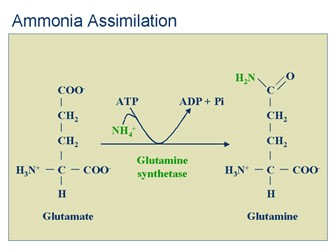Chapter 16: MOA Part 2: Amino Acid Synthesis Inhibitors & Nitrogen Metabolism Inhibitors
16.9 The Nitrogen Metabolism Inhibitor

One more herbicide Mode of Action interferes with nitrogen metabolism, which also leads to interference with amino acid production. Specifically it interferes with the production of the amino acid glutamine.
The Biochemical Pathway

As seen in the biochemical pathway summary above, the enzyme called glutamine synthetase converts ammonia (NH4) into an amino acid (glutamine). Remember that amino acids contain nitrogen. The ammonia comes from other normal plant processes.
Herbicide that Inhibits Nitrogen Metabolism
Like other herbicide classes, in this herbicide class blocks a critical enzyme to shut down a pathway. In this case, inhibitors block the activity of glutamine synthetase. This results in a buildup of ammonia that becomes toxic, as well as a lack of the amino acid glutamine. In turn photorespiration and photosynthesis is inhibited ultimately resulting in plant death. Glufosinate is the only herbicide in this class.
Resistance to Nitrogen Metabolism Inhibitor
At this point, the Take Action group reports only one weed species that has shown resistance to this herbicide in the US. The International Survey of Herbicide Resistant Weeds is reporting 3 internationally (www.weedscience.org): Goosegrass in Malaysia, Italian Ryegrass in Oregon, California and Italy, and Rigid Ryegrass in Greece.
Review and Reflection